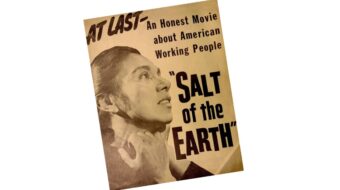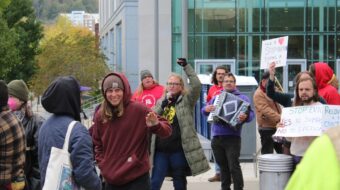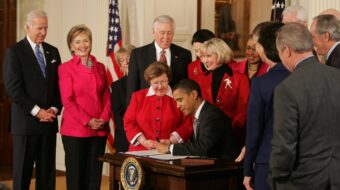
NEW LONDON, Conn.—Labor leaders presented a pro-worker vision for generating sustainable offshore wind energy along the Southern New England coast at a virtual press conference, on Friday, March 15. This effort unites organized labor, the environmental movement, coastal communities, and elected officials. The press conference was moderated by Patrick Crowley, Secretary-Treasurer of the Rhode Island AFL-CIO.
The national significance of this commitment was highlighted by introductory remarks from Liz Shuler, president of the AFL-CIO. Shuler said that good union jobs, environmental issues, offshore wind energy, and building a renewable energy industry are tied together.
The entire labor movement (local, state, and national) is united in this struggle, Shculer said, and building this new industry in a pro-worker way can transform the lives of young, Black, brown, and women workers. She called on offshore wind corporations and the Biden administration to work with the labor movement to build the emerging industry with good union jobs.
Labor leaders from Connecticut, Massachusetts, and Rhode Island are supporting their governors’ efforts to create a multi-state approach to developing the offshore wind energy industry. These labor leaders represent state AFL-CIOs and state Building Trades Councils with hundreds of thousands of union members.
Building trades unions were early supporters of the new offshore wind energy industry, creating support at the state level in collaboration with environmental groups and representatives of coastal communities. Labor-initiated coalitions in these states include the Connecticut Roundtable for Climate and Jobs, Climate Jobs Massachusetts, and Climate Jobs Rhode Island.
These collaborative efforts include working to build the industry supply chain, create new job opportunities through apprenticeships and technical high school programs, and ensure that women and people of color are involved with these training programs and are employed in this growing industry.
Michael Sabatoni, General Secretary-Treasurer of the Laborers International Union of North America, discussed a regional approach to building the offshore wind industry with opportunities in the three southern New England states. He focused on expanding training and job opportunities for underserved populations through apprenticeships.
Sabatoni commented that Rhode Island building trades unions were initially alone in alerting state officials to the potential for sustainable offshore wind energy production and good jobs. Their approach included building broader support, including among the environmental movement.
Connecticut AFL-CIO President Ed Hawthorne provided an overview of organized labor’s approach to this developing industry. He called for fighting climate change with a combination of environmental and economic (job) benefits that will help transition to a greener economy. He also called for a just transition that will provide prevailing wages, ensure Project Labor Agreements (PLAs), fight climate change, and lift up communities.
Frank Callahan, president of the Massachusetts Building Trades Council, discussed the labor movement’s concerns about mature European offshore wind industry corporations coming to the United States and possibly dominating the construction of wind farms along the Atlantic coast.
The U.S. labor movement achieved a breakthrough by requiring that U.S. union workers build these wind farms. He said that U.S. skilled union workers are available to build these projects in the three southern New England states.
Keith Brothers, president of the Connecticut State Building and Construction Trades Council, emphasized the key role of PLAs. These agreements ensure that workers hired to build the wind farms participate in solid training programs (including apprenticeships), have good working conditions, and union-rate wages and benefits.
Brothers also emphasized training to bring in women workers and workers of color and collaborating with technical schools to train new workers for wind industry jobs.
Two workers from Iron Workers Local 37 discussed their experiences working on the Vineyard offshore wind farm. Brayton Willerval said that offshore work was very different than working on land. Tyler Tripp works on the structural side of building the wind farms and observed that he was appreciative of the experience he’d gained so far, and he was happy he had a union.
The cooperative work of both the environmental and labor movements was discussed by Amanda Barker, Policy Advocate of the Green Energy Consumers Alliance, an organization based in Rhode Island and Massachusetts. Its mission is to create a Just Transition to a zero-carbon future. Barker said that developers must accept PLAs to create quality jobs.
She is working on building regional coalitions to develop offshore wind resources. Southern New England is well positioned for the offshore wind energy industry, she argued, due to its densely-populated coastal areas located near the shallow Outer Continental Shelf and strong offshore winds.
Patrick Crowley wrapped up the press conference by saying that the labor and environmental movements were locked hand-in-hand in working together to create support for a sustainable offshore wind energy industry with a Just Transition to a sustainable environment and good-paying union jobs. He commented, “It is happening!”
This approach to fighting the climate crisis and creating jobs that benefit workers, their families, and communities is part of the federal effort by the Biden administration to jump start offshore wind energy production along the U.S. coastlines. This includes manufacturing turbines and related components, assembling and maintaining wind farms, and connecting to onshore power grids.
The press conference illustrates the labor movement’s commitment to provide a leading role in building a broad coalition united in fighting the climate crisis, creating good-paying union jobs, benefitting women and communities of color, and strengthening coastal communities.
What will it take to achieve these goals? A sustained effort to continue building a coalition of labor unions, organizations representing people of color, women’s organizations, environmental groups, and the faith community.
When these organizations work together to mobilize their members and other people who benefit from these initiatives to put pressure on corporations and elected officials, their efforts increase the possibility of achieving these goals. In this way, labor-led coalitions can point the way to addressing the climate crisis by developing sustainable energy resources available off the country’s coasts, creating good-paying union jobs, and creating a more diverse workforce representing coastal communities.
We hope you appreciated this article. At People’s World, we believe news and information should be free and accessible to all, but we need your help. Our journalism is free of corporate influence and paywalls because we are totally reader-supported. Only you, our readers and supporters, make this possible. If you enjoy reading People’s World and the stories we bring you, please support our work by donating or becoming a monthly sustainer today. Thank you!












Comments